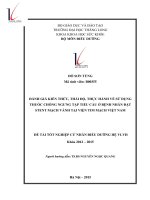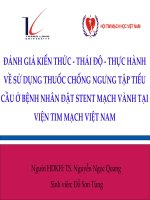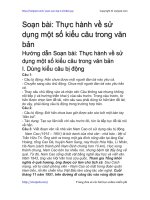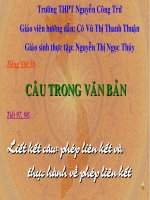Kiến thức và thực hành về sử dụng thuốc lá ở cán bộ văn phòng tại Trường Đại học Y Yangon_ KNOWLEDGE AND PRACTICE OF TOBACCO USE AMONG HOUSE OFFICERS IN UNIVERSITY OF MEDICINE YANGON
Bạn đang xem bản rút gọn của tài liệu. Xem và tải ngay bản đầy đủ của tài liệu tại đây (388.16 KB, 28 trang )
KNOWLEDGE AND PRACTICE OF TOBACCO USE AMONG HOUSE OFFICERS
IN UNIVERSITY OF MEDICINE (2), YANGON
Dr. Thida Aung
Lecturer
Department Of Population And Family Health
University of Public Health, Yangon
1
1.Introduction
All over the world, non-communicable diseases are becoming major public health problem
Tobacco use, one of major risk factor for NCD, become one of the greatest public health threats for the
st
21 century (WHO, 2002)
It is considered to be a leading preventable premature cause of death all over the world
Health professions have an important role in the fight against tobacco use
Tobacco use in health professions becomes a main hindrance in counseling to patients against using
tobacco
2
2.Objectives
General Objective
To study knowledge and practice of tobacco use among house officers in University of Medicine (2), Yangon
in 2012
Specific Objectives
1. To estimate the proportion of smoking and betel chewing with tobacco among the study population
2. To assess knowledge on tobacco use among the study population
3. To find out the factors associated with knowledge of tobacco use among the study population
4. To find out the factors associated with practice of tobacco use among the study population
3
3.Research Methodology
3.1.Study design - Cross-sectional descriptive study
3.2.Study area
- Teaching Hospitals under the
Yangon
3.3.Study period - From September to November,
3.4.Study population- all house officers under the
University of Medicine (2),
2012
University of Medicine (2),
Yangon
4
3.5.Sample size determination
n = z2 p q /d2
n = sample size
z = reliability co-efficient at 95% confidence level
p= 0.1 (prevalence of medical doctors’ tobacco use in Myanmar was 10%,
According to the study of “Myanmar Medical Doctor’s Tobacco Use Survey” in
2003)
q = 0.9
d = margin of error
= 0.05
n = (1.96) x (1.96) x (0.1) x (0.9) / (0.05) x (0.05) = 138
For non-response rate, 10% of sample size was added to calculated sample size.
Therefore final sample size was 150 participants
5
3.6.Sampling procedure
6
3.7.Data collection methods and tools
Face to face interview was conducted by using a set of semi-structured questionnaires that were
pre-tested in Sanpya General Hospital
3.8.Data management and analysis
Data entry
After editing and cleaning the data collected from respondents, the collected data were entered by
Epi-Data version 3.1software
Data analysis
The data analysis were done by using SPSS 16.0 software
α was set at 0.05 for statistical significant
7
3.9. Ethical Consideration
Protocol was submitted to Ethical board of the University of Public Health for permission to
conduct the presented study
Written informed consent with thorough explanation about the study to the participants was
obtained
8
4.Findings
4.1 Socio demographic characteristic of house officers
Among 150 respondents, 76 (50.7%)were male and Mean age of respondents was (22.82) years and
(SD-1.23)
Most of the respondents were Bamar (75.9%) and Buddhist (93%)
Main sources of information on health effects of tobacco were from radio/TV (80.7%). The least
frequent (58.7%) was from poster and pamphlets
Only one-third of the respondents (39%) received training in tobacco cessation approaches during
medical school
9
0.7
0.6
0.66
50.70%
0.5
0.4
0.3
26%
22.70%
smoking status
betel chewing with
tobacco status
22.70%
21%
0.2
0.1
2%2.00%
0
Figure (1)Status of smoking and betel chewing with tobacco among house officers’
parents, family members and friends
10
4.2 General knowledge on tobacco
Regarding on adverse effect of smoking, (78.7%) answered peptic ulcer
Regarding on health hazards in children due to second-hand smoke, 98% correctly responded for
early onset of asthma
Concerning knowledge on health hazards of betel chewing with tobacco, 99.3% of respondents
responded correctly on oral cancer
Regarding on health hazards that can occur in the neonate borne to smoker mother, 86%
responded correctly on still birth and 84% on preterm effect respectively
11
Knowledge on Tobacco law and Control activity
Table (1) Knowledge on tobacco law and control activities in Myanmar (n=150)
12
Knowledge on Tobacco law and Control activity
Table (2) Knowledge upon non-smoking areas (n=150)
13
Knowledge on restrictions of smoking in hospital and medical school buildings
88
90
80
Percent
70
60
50
40
30
20
10
0
of response
5.3
0.7
2.7
3.3
Restrictions of smoking in hospital and medical school buildings
Figure (2) Knowledge on restrictions of smoking in hospital and
medical school buildings
14
Regarding to knowledge level, 71 (47.3%) were low knowledge while 79 (52.7%) were high knowledge
about tobacco use
(Knowledge score equal to and above median was assumed as high knowledge)
15
4.3 Practice on Tobacco use
13
2
21.4
63.6
Never smokers
Non-current smoker
Current smokers
Ex-smoker
Figure (3)Different types of smokers among house officers
16
Never betel chewer
Current betel chewer
Figure (4)Different types of betel chewers (Smokeless tobacco users)
among house officers
17
More than half of current smokers (59.4%)and betel chewers (50%)started to use between their ages of 18
to 21 years
The main initiations for tobacco use were found that for trial and peer pressure
56.2% of current smoker bought cigarette in loose form, 21.9% bought from hospital canteen and 31.2%
smoked in their duty room
nearly half of current smokers (43.8%) smoked daily and (56.2%) chewed betel quid daily
Regarding to cessation practice of tobacco use, 71.9% of current smokers and 56.2% of current betel
chewers had desire to quit
The common reasons for cessation practice of tobacco use were health reason and oral hygiene
18
The smoking habit of respondents was associated with gender and friends’ behaviours (42.1% vs.
0%, p =0.000) and (28.3% vs. 7.8%, p=0.004)
The same results occurred that the betel chewing habit of respondents was associated with gender
and friends’ behaviours (21.1% vs. 0%, p=0.000) and (19.4% vs. 1.4%, p =0.000)
19
4.4 Practice of giving Health education and advice to quit tobacco use to the patients
More respondents gave health education and advice to quit smoking than betel chewing (74.7%
vs. 54.7%)
There was significantly association between their current tobacco use and practice of giving
health education (43.8%, vs. 86.4%, p=0.000)
The current tobacco users less advised to quit tobacco use than non-current tobacco users (50% vs.
81.4%, p=0.000)
20
5. Discussion
Only 39% of the respondents received training in tobacco cessation approaches during medical
school
It may be due to other respondents didn’t remember whether they received or not this training
(recall bias)
proportion of male current smokers in this study was increased than the finding of GHPSS in 2009
but the same result in female respondents (Male = 42% vs. 23.6% and Female = 0% vs. 1.1% )
proportion of male current smokeless tobacco users in this study was not so much different from
the finding of GHPSS in 2009 (Male = 21.1% vs. 22.5% and Female = 0% vs. 0.7% )
21
6. Conclusion
It was found that 21.4%were currents smokers(male- 42% vs. female- 0%)and 10.7% were current
smokeless tobacco users (male- 21.1% vs. female- 0%)
Out of them, 71.9% of current smokers and 56.2% of current betel chewers had ever tried to quit
Most of current tobacco users had a perception that doctor should not use tobacco and should be
role model for cessation of tobacco
Most of current smokers had good knowledge on tobacco hazards and tobacco control activities
but they did not come into daily practice and still had become current tobacco users
22
7. Recommendation
Anti-tobacco health curriculum should be strengthen in middle and high school level to educate young adolescent
not to start tobacco use
Peer education on anti-tobacco measures among youth should also be developed
IEC about legislative measure of smoking should be strengthen and some weakness in the control activities of
smoking should be encouraged by close monitoring
Training in tobacco cessation approaches to provide the patients should be strengthened in the Medical teaching
program and Continuous Medical Education program for improvement of health among tobacco users in the
community
23
7. Limitation of the study
1.
The study was done in only on two teaching hospitals under University of Medicine (2) due to time
limitation
2.
qualitative methods (focus group discussion or in-depth interview method) should be conducted in
combination with questionnaire
3.
Information on amount of tobacco use was obtained according to the response of participants, so there
could be information bias
24
REFERENCES CITED
Aye Aye Win 2009, Knowledge, attitude and practice of tobacco consumption amongshipyard workers, Yangon in 2009, MPH Thesis University of Public Health
Centers for Disease Control and Prevention 2008, Health effects of Smoking
Curbing the Epidemic, Governments and the Economics of Tobacco control 1999,World Bank Publication
Daniel W.W. 2005, A foundation for analysis in the health sciences, Eighth edition, USA
David Hammond, Foong Kin, AreeProhmmo&Sharad K. Sharma 2008, “Patterns of Smoking Among Adolescents in Malaysia and Thailand”: Findings from the International
Tobacco Control South-East-Asia Survey. Asia Pacific Journal of Public Health 2008; vol 20, pp 193 originally published online May 13, 2008
Deepak S S, Sanjay N, Monal M K, Wagh V 2009, Tobacco use amongst the male medical students, Central India, Int J Bio Med Res, 2011: 2(1): 378-381
Gualano.M.R., R.Siliquini, L. Manzoli, A.Firenze. N. Romano, M. S. Cattaruzza : D. Renzi : A. Boccia : G. La Torre 2009,“Tobacco use prevalence, knowledge and attitudes, and
tobacco cessation training among medical students: results of a pilot study of Global Health Professions Students Survey (GHPSS) in Italy”,J Public Health (2012) 20:89–94
HariniPriyaM, Sham S Bhat, SundeepHegde K 2008, Prevalence, Knowledge and Attitude of tobacco use among health professionals in Mangalore City, Karnataka
HlaingHlaingHlaing 2007, Comparison of selected health risk behaviours between first M.B.,B.S students and house surgeons in university of medicine, Mandalay. M.Med.Sc Thesis
(Public Health) University of Medicine (Mandalay)
25









